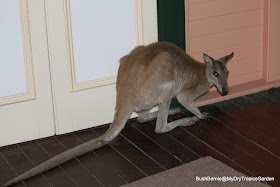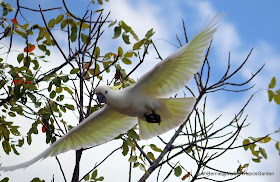Season: mid-Spring and dry season.
It's the middle of our springtime now and the temps. have been quite reasonable. Most days the mercury hovers around 29 deg C, whilst the night-time temps drop to a pleasant 19-20 deg C. All very bearable.
Our dry season continues, although in the last few days we've had the occasional very, very light sprinkle of raindrops. More like a passing mist really, but accompanied by my all-time favourite smell ... the smell of approaching rain. That has been delightful. The fine misty squalls of rain have barely registered though - weather reports state that we've received around 1mm of rain in the last week. That's literally next to nothing!
The stuff that's fallen has barely hit the ground and certainly hasn't penetrated the cement-like ground here. The only evidence that something resembling raindrops has fallen from the sky above, has been the sighting of a couple of tiny raindrops on petals and leaves around the place. Of course, they disappear very quickly with the gusty wind and warm sunlight.
For those who read my last post, you will know why I'm a little over-the-moon about the following event. It seems that the hordes of ravaging wallabies have finally moved on elsewhere. Well, considering they've just about demolished everything edible that they could reach, I'm not surprised. There's very little left that they find tasty.
There was one horrid felon left. It was still munching on whatever I couldn't move from the courtyard garden and the new garden beds over the last two weeks. It was even attempting to get in between all the chairs that I had set up as a barricade out in the courtyard garden! Well, three mornings ago, this was the sight that greeted me at our back door when I got up to start the working day.
It would not move as I approached, so I had to use the other back door. Even after an hour or so, it still hadn't moved, so my hubby shooed it off with a broom from a distance. He tried to be gentle because we had started to think there might be something wrong with the poor thing. Wallabies don't usually hang around on our verandah while we're at home and moving around inside.
Anyway, long story short ... I arrived home from work that afternoon and did my usual patrol checking for my wallaby feasting, and I found the poor thing dead in the front garden bed. Me thinks it ate something that it really shouldn't have, or the accumulation of all the things it had eaten for weeks was just too much!
The upshot of this though is that I have finally been able to move the salvageable potted plants off the courtyard table this weekend and back onto the courtyard pavers. It looks more like a garden space once again. I can't tell you how great that makes me feel. Of course, most of the potted plants need time to recover and bounce back to their former glory, but I'm so pleased to have the plants back where they belong.
Colour elsewhere in the garden is very light on the ground, apart from a couple of hardy plants that were obviously not good enough for the wallabies' nightly menu.
Kalanchoe (not sure of the variety).
Dwarf variegated Bougainvillea.
Alpinia (not sure of the variety).
[Note: thanks for the I.D. Viscount Anthony Fuller. Now I know it's Alpinia purpurata.]
Turnera ulmifolia
Duranta repens
Hippeastrum
Oleander
Elsewhere around the place, there are a couple of trees that are deciduous during our winter months, but with the arrival of Spring, the bare branches start sprouting lots of new leaf growth.
The beautiful new coppery-coloured foliage has appeared on one of my Lagerstroemia speciosa shrubs. It's a lovely sight after the bare branches have been on show for the last couple of months.
My two deciduous Plumeria rubras are showing signs of new leaf growth as well.
I love watching the tiny little leaves emerge from the rounded ends of the branches.
Out in the courtyard, the new leaf growth on the native Sterclia quadrifida or Peanut Tree is very noticeable now.
The branches are leafless throughout the winter months, when the seedpods appear, but when spring arrives, so do the new leaves.
You might notice though that there are splashes of purple up in the canopy of the Sterculia that look decidedly out of place.
That's my Petrea volubilis, or Sandpaper Vine, climbing up through the Sterculia. The Petrea is supposed to grow and cover the pergola, but it much prefers to climb the tree. I've tried countless times to pull it down and try to train it to cover the pergola. It refuses to play along with my plans and just keeps escaping up into the Sterculia.
It's so hard to see the gorgeous flowers of this vine though, as it's so very high up. It's only when I point it out to people, that anyone notices the gorgeous purple sprays.
Out in my courtyard garden, one of my Cycas revolutas has a new 'break' emerging. It's great fun watching these new leafy whirls emerge and get taller and taller. Here's an idea of the progression and pace of new growth:
October 2nd
October 4th
October 5th
October 7th
October 8th
Today.
It's fascinating to see the curly ends slowly unfurl as the branches get longer and longer.
I've finally re-potted the two graceful Belchnum gibbum or Silver Lady Ferns that sit out under the sloping roof facing the courtyard garden. They've been very patient! I decided that whilst I was moving the rescued wallaby-eaten potted plants from the table to the pavers, I really should make the effort and re-pot a few of the other plants that live out around the courtyard too. I think they already look happier.
Just to finish off my journal entry for this week, I'm adding a few of the bird shots I've captured during the last week.
Forest Kingfisher.
Female Fig Bird in the native Olive tree.
Not sure what this little bird is, but it was enjoying a feast of native olives.
Brown-backed Honeyeaters.
Sulphur-crested Cockatoo.
Same Sulphur-crested Cockatoo taking flight.
A pair of Pied Currawongs.
You can't miss those distinctive bright yellow eyes!





































